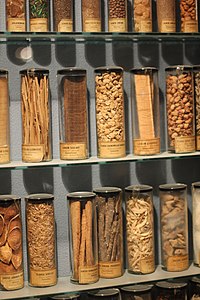
Photo from wikipedia
In Benin, malaria clinical cases, including the larger popular entity called “Palu” are evoked when people get fever. “Palu” is often self-diagnosed and self-medicated at home. This study aimed to… Click to show full abstract
In Benin, malaria clinical cases, including the larger popular entity called “Palu” are evoked when people get fever. “Palu” is often self-diagnosed and self-medicated at home. This study aimed to describe the use of herbal medicine, and/or pharmaceutical medicines for prevention and treatment of malaria at home and the factors associated with this usage. A cross-sectional survey was conducted in Benin in an urban and in a rural area in 2016. Around 600 households in each place were selected by using a random sampling of houses GPS coordinates of the families. The association between socio demographic characteristics and the use of herbal medicine was tested by using logistic regression models. In Cotonou (urban), 43.64% of households reported using herbal or pharmaceutical medicine to prevent “Palu”, while they were 53.1% in Lobogo (rural). To treat “Palu” in Cotonou, 5.34% of households reported using herbal medicine exclusively, 33.70% pharmaceutical medicine exclusively and 60.96% reported using both. In Lobogo, 4% reported using herbal medicine exclusively, 6.78% pharmaceutical medicine exclusively and 89.22% reported using both. In Cotonou, the factors “age of respondent”, “participation to a traditional form of savings” and “low socioeconomic level of the household” were associated with the use of herbal medicine. This study shows the strong use of herbal medicine to prevent “Palu” or even treat it, and in this case it is mostly associated with the use of pharmaceutical medicine. It also highlights the fact that malaria control and care seeking behaviour with herbal medicine remain closely linked to household low-income status but also to cultural behaviour. The interest of this study is mostly educational, with regards to community practices concerning “Palu”, and to the design of adapted behaviour change communication strategies. Finally, there is a need to take into account the traditional habits of populations in malaria control and define a rational and risk-free use of herbal medicine as WHO-recommended.
Journal Title: BMC Public Health
Year Published: 2020
Link to full text (if available)
Share on Social Media: Sign Up to like & get
recommendations!